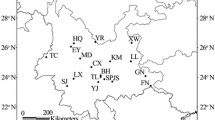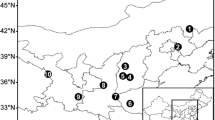Abstract
Four populations representing the entire natural distribution range of Pinus brutia (Ten.) in Crete (Greece) were sampled to determine: (1) Altitudinal variation within populations of Lassithi, Vorizia, Koustagerako, and Samaria, and; (2) Longitudinal variation among the four populations, based on morphological and anatomical differences in cone, needle and seed characteristics. Samples were collected from 10 trees per altitude, at three altitudes in each population. A total of 12 morphological and anatomical traits from needles, cones and seeds were analyzed to assess the altitudinal and longitudinal variations of the species in the island. The number of teeth per cm showed significant (P < 0.01) differences between altitudes in Samaria, Vorizia and Lassithi, while needle length, width and the number of resin canals showed significant differences (P < 0.01) between altitudes in Koustagerako. Cone width showed patterns of variation along the altitudinal gradient in Koustagerako, Samaria and Vorizia. Most traits had their highest means at the middle altitudes (650 masl) in all the four populations. Overall, no clear altitudinal differentiation was detected, probably due to high rate of gene flow. Longitudinal variability showed a clear pattern of differentiation along the east–west climatic gradient. Needle length, width, sheath length, number of teeth per cm and the number of resin canals were the most useful traits for determining the climatic gradient clines.
Similar content being viewed by others
References
Alemdag S. 1962. Development, yield and management rules of red pine (Pinus brutia) forest in Turkey. Orm. Aras. Enst. Tek. Bull. 11: 160 (in Turkish with English summary).
Alizoti P. 2000. Evolution of genetic parameters in the group halepensis Ph.D. Thesis. Department of Forestry and Natural Resources, Aristotle University of Thessaloniki, Greece 381 pp.
Arbez M. 1974. Distribution, ecology and variation of Pinus brutia in Turkey. Forest Genet. Res. Inf. No. 3. FAO, 21–33.
Bradshaw A.D. 1965. Evolutionary significance of phenotypic plasticity in plants. Adv. Genet. 13: 115–155.
Critchfield W.B. and Little E.L. 1966. Geographic distribution of the pines of the world. USDA, For. Serv. Misc. Publ. No. 991.
Ganiatsas K. 1976. The vegetation of Crete. Kretologia II: 1–38, Herakleion, Crete.
Isik K. and Isik F. 1999. Genetic variation in Pinus brutia Ten. in Turkey: II. Branching and crown traits. Silvae Genet. 48(6): 293–302.
Isik F., Isik K. and Lee S.J. 1999. Genetic variation in Pinus brutia Ten in Turkey: I. Growth biomass and stem quality traits. Forest Genet. 6(2): 89–99.
Kara N., Korol L., Isik K. and Schiller G. 1997. Genetic diversity in Pinus brutia Ten: Altitudinal variation. Silvae Genet. 46(2–3): 155–161.
Kaya J. and Isik F. 1997. The pattern of genetic variation in shoot growth of Pinus brutia Ten. Population from the Toros Mountain in Turkey. Silvae Genet. 46(2–3): 73–81.
Mason H.L. and Langenheim J.H. 1961. Natural selection as an ecological concept. Ecology 42(1): 158–165 (cited by Zobel B. and Talbert J. 1984).
Matziris D. and Tziovaras E.L. 1988. Variation in morphological and anatomical needle characteristics in brutia pine provenances. Forest Res. IX: 193–213 (Greek with English Summary)
Mirov N.T. 1966. The Genus Pine. Ronald Press Co., New York, 602 pp.
Nahal I. 1983. LE PIN BRUTIA (Pinus brutia Ten. subsp. brutia). Premiere partie. Foret mediterraneenne 2(3): 165–172.
Nahal I. 1984. LE PIN BRUTIA (Pinus brutia Ten. subsp. brutia). Deuxieme partie. Foret mediterraaneenne, VI(1): 5–16.
Palmberg C. 1975. Geographic variation and early growth in south-eastern semi arid Australia of Pinus halepensis (Mill.) and P. brutia (Ten.) species complex. Silvae Genet. 24(5–6): 150–160.
Panetsos K.P. 1975. Natural hybridization between Pinus brutia and Pinus halepensis in Greece. Silvae Genet. 24(5–6): 163–168.
Panetsos K.P. 1981. Monograph of Pinus halepensis (Mill.) and Pinus brutia (Ten.). Ann. For. 9(2): 37–77.
Panetsos K.P. 1986. Genetics and breeding in the group halepensis. Foret Mediterraneenee, VIII 1.
Panetsos K.P. and Mitsopoulos D. 1988. Origin and evolution of forest vegetation in the island of Crete. Chaniotiki newspaper (in Greek).
Panetsos K.P., Scaltoyiannis A., Aravanopoulos F.A., Dounavi K. and Dimitrakopoulos A. 1997. Identification of Pinus brutia Ten., P. halepensis Mill. and their putative hybrids. Silvae Genet. 46: 253–257.
Panetsos K.P., Aravanopoulos F.A. and Scaltsoyiannis A. 1998a. Genetic variation of Pinus brutia from islands of the Northeastern Aegean Sea. Silvae Genet. 42(2-3): 115–120.
Panetsos K.P., Aravanopoulos F.A., Scaltsoyiannis A. and Dimitrakopoulos A. 1998b. Final consolidated report of the laboratory of Forest Genetics. (Project FIREGENE, AIR3-CT93-0803, CEC). Aristotle University of Thessaloniki, Greece, 25 pp.
Papaioannou J. 1935. The limits of geographic distribution of Pinus halepensis and Pinus brutia in N.E. Chalkidiki and their associated vegetation. Bull. Nat. Sc. Athens 1–13 (in Greek) (cited by Panetsos K.P. 1981).
Roche L. 1969. A genecology study of genus Picea in British Columbia. New Phytol. 68: 505–554.
Rosenan N. 1965. Characteristics of the climate of Crete, with special emphasis upon the Messara plain. AGRIDEV, Crete Development Plan IIIb: 1–15.
SAS (Statistical Analysis Systems) 1988. SAS procedures guide for personal computers. SAS Institute, Inc., North Carolina, USA.
Sefik Y. 1965. Studies on the cone and seed of Pinus brutia. 1st Univ. Or. Fak. Derg. 14-A-2: 35–70.
Stern K. and Roche L. 1974. Genetics of forest ecosystems. Springer Verlag, New York. 330 pp.
Vidacovic M. 1991. Conifers, Morphology and Variation. CAB International Wallinford, Oxon, 108 DE, UK, 755 pp.
Zobel B. and Talbert J. 1984. Applied Forest Tree Improvement. John Wiley and Sons. Inc., New York, 65–92.
Zohary, M. and Orshan, G. 1965. An outline of the geobotany of Crete. Israel J. Bot. 4: 1–49.
Author information
Authors and Affiliations
Corresponding author
Rights and permissions
About this article
Cite this article
Dangasuk, O., Panetsos, K. Altitudinal and longitudinal variations in Pinus brutia (Ten.) of Crete Island, Greece: some needle, cone and seed traits under natural habitats. New Forests 27, 269–284 (2004). https://doi.org/10.1023/B:NEFO.0000022227.33131.f0
Issue Date:
DOI: https://doi.org/10.1023/B:NEFO.0000022227.33131.f0




